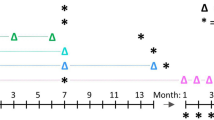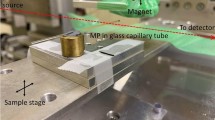Abstract
We introduce a lung inflation-fixation protocol to examine the distribution and gene transfer efficiency of fluorescently tagged lipoplexes using fluorescence confocal microscopy within thick lung tissue sections. Using this technique, we tested the hypothesis that factors related to lipoplex distribution were the predominant reason that intravenous (i.v.) administration of lipoplex was superior to intratracheal (i.t.) administration for gene transfer in the murine lung. Lipoplex distribution was analyzed using digitized images of overlapping fields, reconstructed to view an entire lung lobe. Intravenously administered lipoplexes were confined to the capillary network and homogenously distributed throughout the lung lobe. In contrast, i.t. administration resulted in regional distribution of lipoplex, concentrated around bronchioles and distal airways. Not all the bronchioles were stained with lipoplex, suggesting that the airway-administered solution became channeled through certain bronchiolar pathways. A fluorescent oligonucleotide was used as a marker for cytoplasmic release of nucleic acids. Quantification of the resulting fluorescent nuclei was used to define the relationship between cytoplasmic release of nucleic acids and gene expression. Endothelial cells were stained after i.v. administration, and epithelial cells were stained after i.t. administration. The delivery of nucleic acids was also more homogeneous with i.v. administration of lipoplex than with i.t. administration. After i.t. administration, it was notable that high concentrations of fluorescent nuclei correlated with low GFP expression. This suggested that toxicity was associated with high local concentrations of cationic lipoplexes. The ratio of GFP-expressing cells to fluorescent nuclei indicated that capillary endothelial cells were more efficient in gene expression per delivery event than were pulmonary epithelial cells. Thus, the greater gene expression efficiency of i.v. administered lipoplexes was due not only to the initial distribution but also to the greater efficiency of the vascular endothelial cells to appropriately traffic and express the foreign gene.
This is a preview of subscription content, access via your institution
Access options
Subscribe to this journal
Receive 12 print issues and online access
$259.00 per year
only $21.58 per issue
Buy this article
- Purchase on Springer Link
- Instant access to full article PDF
Prices may be subject to local taxes which are calculated during checkout






Similar content being viewed by others
References
Felgner PL et al. Nomenclature for synthetic gene delivery systems Hum Gene Ther 1997 8: 511–512
Van der Woude I et al. Parameters influencing the introduction of plasmid DNA into cells by the use of synthetic amphiphiles as a carrier system Biochim Biophys Acta 1995 1240: 34–40
Eastman SJ et al. Optimization of formulations and conditions for the aerosol delivery of functional cationic lipid: DNA complexes Hum Gene Ther 1997 8: 313–322
Mislick KA, Baldeschwieler JD . Evidence for the role of proteoglycans in cation-mediated gene transfer Proc Natl Acad Sci USA 1996 93: 12349–12354
Belting M, Petersson P . Intracellular accumulation of secreted proteoglycans inhibits cationic lipid-mediated gene transfer. Co-transfer of glycosaminoglycans to the nucleus J Biol Chem 1999 274: 19375–19382
Mounkes LC et al. Proteoglycans mediate cationic liposome–DNA complexed-based gene delivery in vitro and in vivo J Biol Chem 1998 273: 26164–26170
Brigham KL et al. In vivo transfection of murine lungs with a functioning prokaryotic gene using a liposome vehicle Am J Med Sci 1989 298: 278–281
Meyer KB et al. Intratracheal gene delivery to the mouse airway: characterization of plasmid DNA expression and pharmacokinetics Gene Therapy 1995 2: 450–460
Zhu N, Liggitt D, Liu Y, Debs R . Systemic gene expression after intravenous DNA delivery into adult mice Science 1993 261: 209–211
Barron LG, Meyer KB, Szoka FC . Effects of complement depletion on the pharmacokinetics and gene delivery mediated by cationic lipid–DNA complexes Hum Gene Ther 1998 9: 315–323
Mahato RI et al. Physicochemical and pharmacokinetic characteristics of plasmid DNA/cationic liposome complexes J Pharm Sci 1995 84: 1267–1271
McLean JW et al. Organ-specific endothelial cell uptake of cationic liposome–DNA complexes in mice Am J Physiol 1997 273: H387–404.
Deshpande D et al. Target specific optimization of cationic lipid-based systems for pulmonary gene therapy Pharm Res 1998 15: 1340–1347
Griesenbach U et al. Comparison between intratracheal and intravenous administration of liposome–DNA complexes for cystic fibrosis lung gene therapy Gene Therapy 1998 5: 181–188
Gorman CM et al. Efficient in vivo delivery of DNA to pulmonary cells using the novel lipid EDMPC Gene Therapy 1997 4: 983–992
Blezinger P et al. Intratracheal administration of Interleukin-12 plasmid-cationic lipid complexes inhibits murine lung metasteses Hum Gene Ther 1999 10: 723–731
Oudrhiri N et al. Gene transfer by guanidinium-cholesterol cationic lipids into airway epithelial cells in vitro and in vivo Proc Natl Acad Sci USA 1997 94: 1651–1656
Li S et al. Dynamic changes in the characteristics of cationic lipidic vectors after exposure to mouse serum: implications for intravenous lipofection Gene Ther 1999 6: 585–594
Stribling R et al. Aerosol gene delivery in vivo Proc Natl Acad Sci USA 1992 89: 11277–11281
Scheule RK et al. Basis of pulmonary toxicity associated with cationic lipid-mediated gene transfer to the mammalian lung Hum Gene Ther 1997 8: 689–707
McDonald RJ et al. Aerosol delivery of lipid: DNA complexes to lungs of rhesus monkeys Pharm Res 1998 15: 671–679
Chin DJ et al. Rapid nuclear accumulation of injected oligodeoxyribonucleotides New Biol 1990 2: 1091–1100
Zelphati O, Szoka FC . Mechanism of oligonucleotide release from cationic liposomes Proc Natl Acad Sci USA 1996 93: 11493–11498
Lukacs G et al. Size-dependent DNA mobility in cytoplasm and nucleus J Biol Chem 2000 275: 1625–1629
Li S, Huang L . In vivo gene transfer via intravenous administration of cationic lipid-protamine–DNA (LPD) complexes Gene Therapy 1997 4: 891–900
Smith JG et al. Characterization and in vivo testing of a heterogeneous cationic lipid–DNA formulation Pharm Res 1998 15: 1356–1363
Xu Y, Hui S-W, Frederick P, Szoka FC . Physicochemical characterization and purification of cationic lipoplexes Biophys J 1999 77: 341–353
Liu Y et al. Factors influencing the efficiency of cationic liposome-mediated intravenous gene delivery Nat Biotechnol 1997 15: 167–173
Hofland HE et al. In vivo gene transfer by intravenous administration of stable cationic lipid/DNA complex Pharm Res 1997 14: 742–749
Mahato RI et al. Biodistribution and gene expression of lipid/plasmid complexes after systemic administration Hum Gene Ther 1998 9: 2083–2099
Simionescu M, Simionescu N . Endothelial surface domains in pulmonary alveolar capillaries. In: Ryan US (ed.) Pulmonary Endothelium in Health and Disease Marcel Dekker: New York 1987 pp 35–62
Barron LG, Gagne L, Szoka FC . Lipoplex-mediated gene delivery to the lung occurs within 60 minutes of intravenous administration Hum Gene Ther 1999 10: 1683–1694
Templeton NS et al. Improved DNA:liposome complexes for increased systemic delivery and gene expression Nat Biotechnol 1997 15: 647–652
Brain JD, Knudson DE, Sorokin SP, Davis MA . Pulmonary distribution of particles given by intratracheal instillation or by aerosol inhalation Environ Res 1976 11: 13–33
Schanker LS, Mitchell EW, Brown RAJ . Species comparison of drug absorption from the lung after aerosol inhalation or intratracheal injection Drug Metab Dispos 1986 14: 79–88
Coonrod A, Li F-Q, Horwitz M . On the mechanism of DNA transfection: efficient gene transfer without viruses Gene Therapy 1997 4: 1313–1321
Zelphati O, Liang X, Hobart P, Felgner PL . Gene chemistry: functionally and conformationally intact fluorescent plasmid DNA Hum Gene Ther 1999 10: 15–24
Meyer KEB, Thompson MM, Barron LG, Szoka FC . Cationic liposome formulations containing cholesterol increase plasmid persistence and gene expression in the mouse lung after intratracheal administration J Liposome Res (submitted)
Eastman SJ et al. A concentrated and stable aerosol formulation of cationic lipid: DNA complexes giving high-level gene expression in mouse lung Hum Gene Ther 1997 8: 765–773
Abra RM, Schreier H, Szoka FC . The use of a new radioactive-iodine lipid marker to follow in vivo disposition of liposomes: comparison with an encapsulated aqueous space marker Res Commun Chem Pathol Pharmacol 1982 37: 199–213
Acknowledgements
We gratefully acknowledge financial support from the following agencies: NIH DK-46052–05 (FCS), The Cystic Fibrosis Foundation UCSF RDP, and the California Statewide Tobacco RDP 6RT-0109. Dr Szoka has a financial interest in and serves as a consultant to Valentis, Inc., a biotechnology company developing gene medicines. We thank Donald McDonald for advice and access to a vibrotome for use in this project.
Author information
Authors and Affiliations
Rights and permissions
About this article
Cite this article
Uyechi, L., Gagné, L., Thurston, G. et al. Mechanism of lipoplex gene delivery in mouse lung: binding and internalization of fluorescent lipid and DNA components. Gene Ther 8, 828–836 (2001). https://doi.org/10.1038/sj.gt.3301461
Received:
Accepted:
Published:
Issue Date:
DOI: https://doi.org/10.1038/sj.gt.3301461
Keywords
This article is cited by
-
Enhanced Notch3 signaling contributes to pulmonary emphysema in a Murine Model of Marfan syndrome
Scientific Reports (2020)
-
Therapeutic siRNA: state of the art
Signal Transduction and Targeted Therapy (2020)
-
An efficient liposomal gene delivery vehicle using Sendai F/HN proteins and protamine
Cancer Gene Therapy (2008)
-
Expression of thymidine kinase driven by an endothelial-specific promoter inhibits tumor growth of Lewis lung carcinoma cells in transgenic mice
Gene Therapy (2003)
-
Electroporation as a method for high-level nonviral gene transfer to the lung
Gene Therapy (2003)



